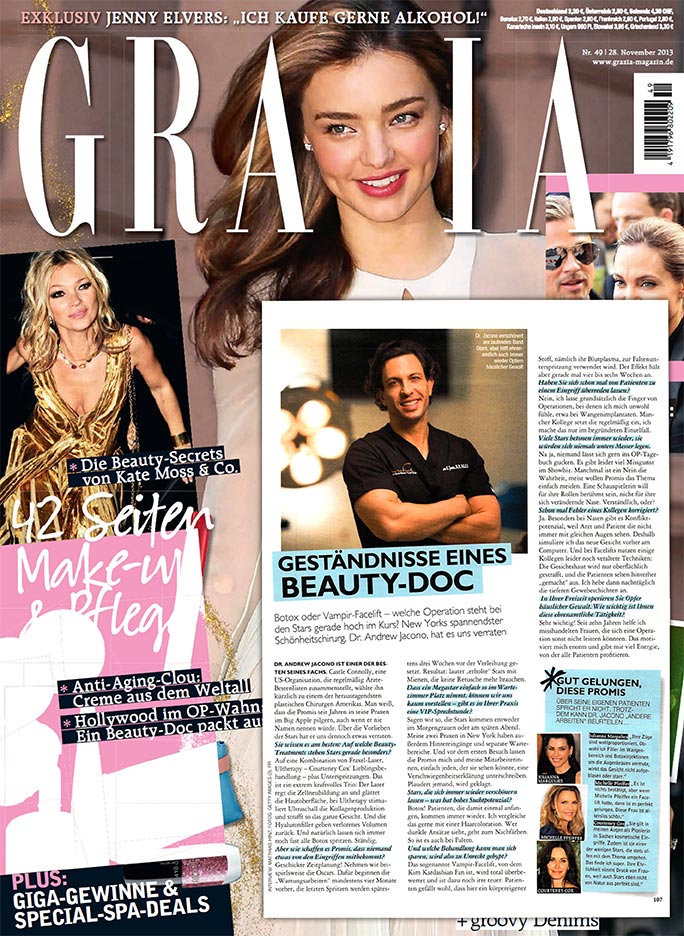New York Center for Facial Plastic Surgery
Schedule a consultation
Schedule today

Information about surgical and non-surgical facial rejuvenation procedures in New York, NY with Dr. Andrew Jacono

Dr. Andrew Jacono may be one of the best plastic and reconstructive surgeons in the world, but above all, he is a proponent of facial rejuvenation. This term encompasses self-care as a whole. In other words, skincare, laser treatments, and even surgery fall under the umbrella of facial rejuvenation. If it makes you look better, it may be worth trying out for yourself.
That said, some facial rejuvenation techniques are more effective than others. Creams, serums, and moisturizers can firm wrinkles, but they do not offer more dramatic structural changes. In fact, they cannot reverse serious symptoms of aging. If your skin has sagged, for example, they are practically useless.
“It’s important to have a good skincare routine, but it’s not a be-all-end-all,” says Dr. Jacono. “If you want more reliable, visible results, it’s worth visiting a medical professional who specializes in aesthetic treatments.” There are many non-invasive and surgical options with varying degrees of success. A few of these are outlined below.
Non-invasive treatments are the next step in facial rejuvenation. They include laser resurfacing, Botox injections, and hyaluronic acid fillers.
Lasers work by directing heat energy into facial tissue. Ablative lasers destroy the outer layer of skin to achieve their goals. Non-ablative lasers direct heat underneath the epidermis to firm underlying tissue. Both types of lasers stimulate the production of collagen, a naturally occurring compound that repairs skin cells. After treatment, the skin gradually becomes tighter, and wrinkles fade. Results can last between 3 and 5 years.
Botox, or botulinum toxin, is an injectable solution that eliminates wrinkles in key facial areas. It does this by blocking chemical signals from nerves that cause muscle contractions. This temporarily relaxes muscles, which reverses wrinkles. It also makes the skin smoother. There is virtually no downtime and results last between 3 and 4 months. After that, maintenance is generally required.
Facial fillers are another kind of injectable treatment. Their primary ingredient is hyaluronic acid, a naturally occurring compound in the body. Normally, hyaluronic acid acts as a joint lubricant and also helps to smooth and firm the skin. When injected, however, hyaluronic acid can add volume to the face. It can also fill in wrinkles, troughs, and other blemishes. Generally, hyaluronic acid lasts longer than Botox—between 6 and 12 months—and results are more dramatic. There are many different brands of hyaluronic acid, all geared toward different goals. Juvéderm, for example, primarily adds volume. Restylane, on the other hand, corrects deep wrinkles and folds.
As effective as non-invasive cosmetic treatments can be, they have drawbacks. First and foremost, they are temporary. For those reluctant to undergo surgery, this may be preferable, but in the long run, it may become frustrating to visit a dermatologist or surgeon every few months.
Additionally, facial fillers may lose their effectiveness over time. This is because they quite literally stretch the tissue. More often than not, patients who swear by non-invasive treatments end up getting surgery later down the line. “Filler fatigue—or the diminishing returns of fillers—is a very real problem,” says Dr. Jacono. “I routinely see patients in their late thirties and early forties who have used fillers for years, and they’ve become dissatisfied. The vast majority of the time, they wind up opting for surgery anyway. At a certain point in their beauty journey, fillers just don’t cut it anymore. It’s unfortunate, but it’s the truth.”
For those fed up with the limitations of non-invasive treatments, Dr. Jacono recommends one thing: surgery.
“There is nothing that lasers, Botox, and fillers do that surgery can’t do better,” says Dr. Jacono. “Non-invasive options attempt to offer similar outcomes, but at a greatly reduced effectiveness. This is because they can’t directly manipulate facial structure. Instead, they treat the symptomology, rather than the cause, of a particular issue, like wrinkling. Surgery, on the other hand, fundamentally alters the aging face. It also offers results that last much longer. In many cases, the outcomes are permanent, and require no maintenance.”
For patients who experience jowling, wrinkling, and sagging, Dr. Jacono recommends procedures such as facelift, neck lift, and even blepharoplasty, which targets the eyes. For those who want to go the extra mile, he recommends the Extended Deep-Plane Facelift, an innovative technique that he pioneered and mastered over many years.
“My deep-plane facelift is a major improvement over the typical facelift,” says Dr. Jacono. “More traditional methods separate the skin and muscle and pull everything too tight. My technique, on the other hand, treats the skin and muscle as a single unit and pulls everything vertically rather than horizontally. This makes the face look much more natural. It also makes my patients look anywhere from 15 to 20 years younger.”
With so many options out there, it may be difficult to decide which treatment is best. However, if you want to look great as long as you can, surgery may be the only way to go.

Accessibility: If you are vision-impaired or have some other impairment covered by the Americans with Disabilities Act or a similar law, and you wish to discuss potential accommodations related to using this website, please contact our Accessibility Manager at (212) 570-2500 .